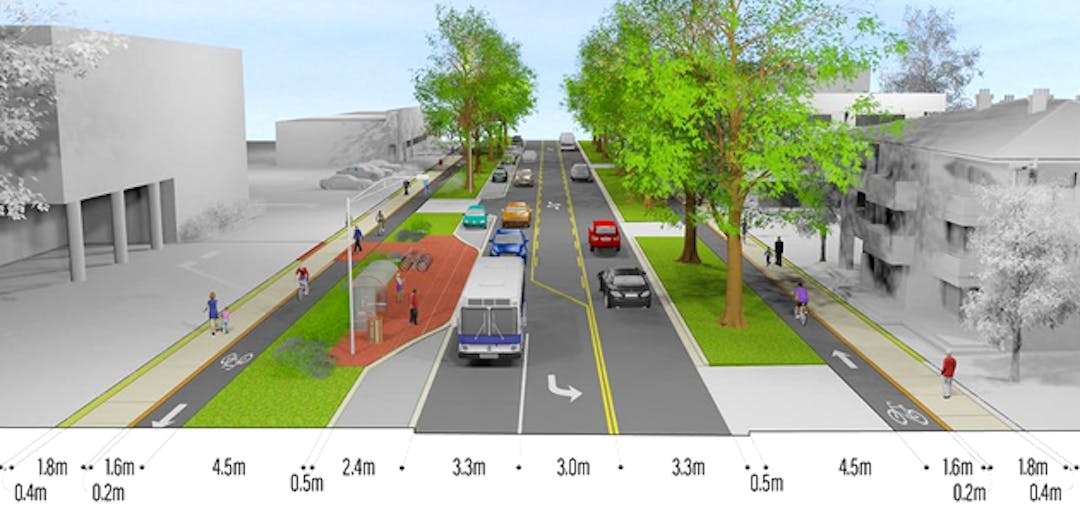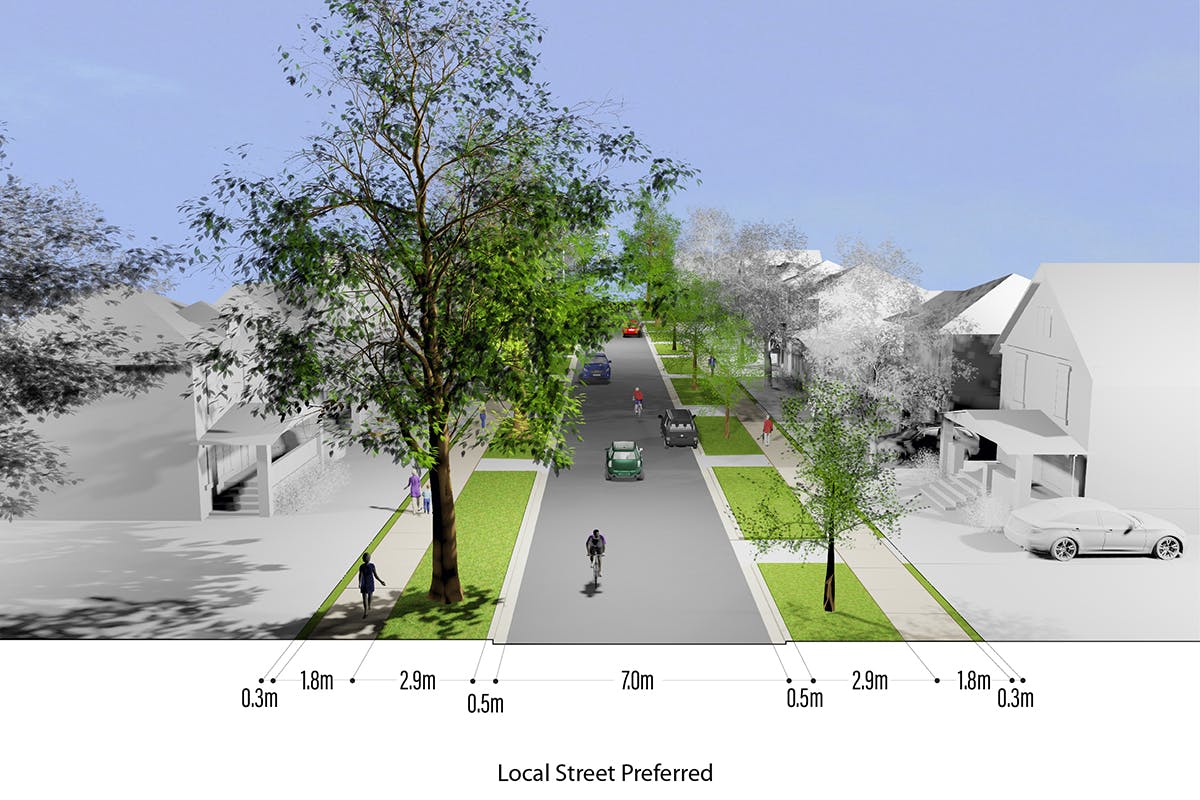Safe Speeds & Complete Streets
Consultation has concluded

Road safety for all modes of transportation is a major priority for staff and city council, based on resident feedback during the election and our ongoing community engagement activities.
The City is developing a Complete Streets approach and guidelines that design for calmer traffic speeds and better balance the needs of pedestrians, cyclists, transit users and motorists. City staff are seeking feedback on the draft Complete Streets guidelines, through a survey (closes Sept 17). You can also provide your input in person at the event listed in the Key Dates section of this page.
The City of Kitchener has completed a review looking at reducing the speed limit in residential neighbourhoods from 50 km/h to 40 km/h. A pilot project in three neighbourhoods has been approved by City Council.
Road safety for all modes of transportation is a major priority for staff and city council, based on resident feedback during the election and our ongoing community engagement activities.
The City is developing a Complete Streets approach and guidelines that design for calmer traffic speeds and better balance the needs of pedestrians, cyclists, transit users and motorists. City staff are seeking feedback on the draft Complete Streets guidelines, through a survey (closes Sept 17). You can also provide your input in person at the event listed in the Key Dates section of this page.
The City of Kitchener has completed a review looking at reducing the speed limit in residential neighbourhoods from 50 km/h to 40 km/h. A pilot project in three neighbourhoods has been approved by City Council.
-
City Council approves Complete Streets
Share City Council approves Complete Streets on Facebook Share City Council approves Complete Streets on Twitter Share City Council approves Complete Streets on Linkedin Email City Council approves Complete Streets link
On October 28, Kitchener City Council approved Kitchener's first Complete Streets guidelines, with a vision that every street in Kitchener is safe, comfortable and convenient for all. The guidelines will be applied to future street reconstruction projects and new development.
You can read the Community Edition of the guidelines for a brief, visually engaging summary of how the guidelines will shape future street design. For further context, view the staff report (starting on page 2-1)
Thank you to the 610 people who got involved and helped to shape the guidelines. Your input is greatly appreciated.
-
Complete Streets Engagement Summary
Share Complete Streets Engagement Summary on Facebook Share Complete Streets Engagement Summary on Twitter Share Complete Streets Engagement Summary on Linkedin Email Complete Streets Engagement Summary link
In the first phase of engagement for Complete Streets, a variety of engagement tactics were conducted to reach a broad cross-section of our community and hear from a variety of perspectives. Thank you to the 339 people who were directly involved in shaping Complete Streets.
Based on community feedback conducted by Wilfrid Laurier students, they recommend that the Complete Streets guidelines be made more understandable by simplifying wording and eliminating redundancies or by including comprehensive descriptions, and detailed visual aids. Their recommendations for street design include traffic calming, lower speed limits and adding features such as wider sidewalks, separated bike lanes, trees and greenery, benches, and better lighting.
To learn more, read the brief summary or the full report.
A full draft of the guidelines will be available for your comments later this summer.
-
Slower speeds make for safer streets
Share Slower speeds make for safer streets on Facebook Share Slower speeds make for safer streets on Twitter Share Slower speeds make for safer streets on Linkedin Email Slower speeds make for safer streets link
Studies show that speeding is a significant contributing factor leading to severe injuries and fatal collisions worldwide. The likelihood of survival in a collision between a vehicle and a pedestrian is approximately 15 per cent when the vehicle is traveling at 50 km/h. However, the likelihood of survival increases to 75 per cent when the vehicle is traveling at 40 km/h or below.

Studies show that higher speeds not only increase the risk of severe injuries and fatal collisions, but also increase the risk of a collision happening in the first place. Higher speeds increase the distance required to stop safely by reducing both the braking time and the driver’s reaction time available to prevent a collision from happening. A stopping distance of approximately 85 metres is required for a vehicle travelling at 60 km/h, 63 metres for a vehicle travelling at 50 km/h, and 45 metres for a vehicle travelling at 40 km/h.

You can read this article for more information and take our survey to tell us what you think.
-
Complete streets are for everyone
Share Complete streets are for everyone on Facebook Share Complete streets are for everyone on Twitter Share Complete streets are for everyone on Linkedin Email Complete streets are for everyone link
Complete Streets are safe, comfortable and convenient for all modes of transportation, and all ages and abilities. Complete streets also contribute to advancing sustainability, health, and social goals. In short, Complete Streets are for everyone!
A Complete Streets approach uses every street project as an opportunity to improve the design and functionality of a street by enhancing all transportation modes and supporting livable neighbourhoods.
You can learn more about our draft principles and take our survey to tell us what you think.
Key Dates
-
September 12 2019
Life Cycle
-
Open
Safe Speeds & Complete Streets has finished this stageThis consultation is open for contributions until March 25, 2019.
-
Safe speeds and Complete Streets comments under review
Safe Speeds & Complete Streets has finished this stageContributions to this stage of consultation are closed and under review.
-
Safe speeds final report
Safe Speeds & Complete Streets has finished this stageStaff will report back to city council on key outcomes in summer 2019.
-
Draft Complete Streets guidelines
Safe Speeds & Complete Streets has finished this stageComments are welcome on a draft of the Complete Streets guidelines in August 2019
-
Complete Streets final comments under review
Safe Speeds & Complete Streets has finished this stageContributions to this final stage of consultation for Complete Streets are closed and under review.
-
Complete Streets final report
Safe Speeds & Complete Streets is currently at this stageThe final outcomes of the consultation include a summary of what we heard and a staff report to city council with the final Complete Streets guidelines and implementation plan. Presented in October 2019.
Who's listening
-

Phone 519-741-2200 x 7314 Email darren.kropf@kitchener.ca -

Phone 519-741-2200 ext 7665 Email faranak.hosseini@kitchener.ca



